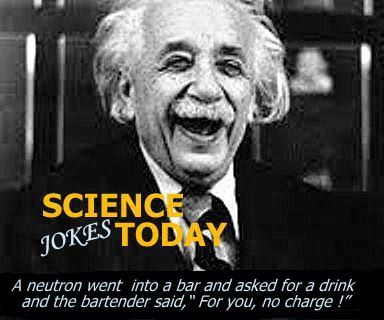
SCIENCE Jokes TODAY
What made Einstein use the letter 'c" to signify the velocity of light in his paper on the Theory of Relativity? Well, here is a little known, true story about it : (attributed to Paul Harvey)
Albert Einstein was just about finished his
work on the theory of special relativity, when he decided to take a break and
go on vacation to Mexico. So he hopped on a plane and headed to Acapulco. Each
day, late in the afternoon, sporting dark sunglasses, he walked in the white
Mexican sand and breathed in the fresh Pacific sea air. On the last day, he
paused during his stroll to sit down on a bench and watch the Sun set. When the
large orange ball was just disappearing, a last beam of light seemed to radiate
toward him. The event brought him back to thinking about his physics work.
"What symbol should I use for the speed of light?" he asked himself.
The problem was that nearly every Greek letter had been taken for some other
purpose. Just then, a beautiful Mexican woman passed by. Albert Einstein just
had to say something to her. Almost out of desperation, he asked as he lowered
his dark sunglasses, "Do you not zink zat zee speed of light is zery
fast?" The woman smiled at Einstein (which, by the way, made his heart
sink) and replied, "Si."
And you know the rest of the story
*********
Q: Why are quantum physicists so poor at sex?
A: It's just Heizenberg's Uncertainty Principle at work.
A: It's just Heizenberg's Uncertainty Principle at work.
Q: What! How come?
A: You see, when they find the position, they
can't find the momentum, and when they have the momentum, they can't find the
position.
*********
Q: What is the simplest way to observe the optical Doppler
effect?
A: Go out on the highway at night and watch the cars.
A: Go out on the highway at night and watch the cars.
Q: How will it help?
A: Well, you will observe that the lights of
the cars approaching you are white, while the lights of the ones moving away
from you are red.
*********
Dr. Pronoy Roy, an experimentalist comes running excitedly into Dr. Jain's
office, waving a graph taken off his latest neutron scattering experiment. 'Hmmm,' says Dr. Jain who is a theoretical physicist, 'That's exactly where I would expect to see the peak. As I had written in my last paper in the Physical Review, ............(a long theoretical explanation follows).' Suddenly, in the middle of it, Dr. Roy interrupts and says 'Wait a minute', studies the chart for a second, and says,
'Oops, I'm sorry, this is upside down.' and turns the graph through 180 degrees. 'Hmmm,' says the theorist, ' I was coming to that. That's exactly the position, where we should expect a dip to occur and the reason is .........' and the explanation continues.
*********
If you enter a laboratory and see an experiment in progress, how
will you know which class is it? Well,
if it’s green and wiggles, it’s a biology experiment. If it stinks, it’s
chemistry and if it doesn’t work, then it is physics.
What is the difference
between a physicist, an engineer, and a mathematician?
If an engineer walks into a room and sees a
fire in the middle and a bucket of water in the corner, he takes the bucket of
water and pours it on the fire and puts it out.
If a physicist walks into a room and sees a fire in the middle and a bucket of water in the corner, he takes the bucket of water and pours it eloquently around the fire and lets the fire put itself out.
If a physicist walks into a room and sees a fire in the middle and a bucket of water in the corner, he takes the bucket of water and pours it eloquently around the fire and lets the fire put itself out.
If a mathematician walks into a room and sees
a fire in the middle and a bucket of water in the corner, he convinces himself
there is a solution and leaves. (credit: Jeremiah Jazdzewski)
***********
It is said that in 1921 George de Hevesey suspected that the leftovers from his dinner
were not thrown away, but kept for the next day. To check that he added a
minimal amount of a radioactive substance to his leftovers. The next day, he tested the goulash soup that was served to him with a Geiger counter. The soup was indeed found to be radioactive. And this
way, the radioactive tracers were discovered.
Source:
Adriaan van der Woude & Rob de Meijer, "Radioactiviteit", Natuurwetenschap
& Techniek, 2003
*********** x **********

No comments:
Post a Comment